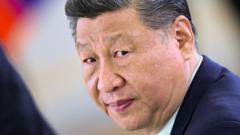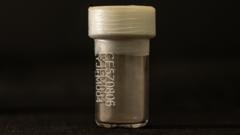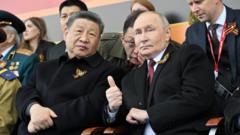Australia’s commitment to enhance its rare earth capabilities could challenge China's dominance, but refining remains a key hurdle.
China's Rare Earth Export Halt: Will Australia Bridging the Gap?

China's Rare Earth Export Halt: Will Australia Bridging the Gap?
As China restricts rare earth exports amid rising trade tensions, Australia proposes a strategic investment to bolster its critical minerals industry.
China has recently implemented strict export restrictions on seven rare earth elements, essential components widely used in advanced technologies such as electric vehicles, weaponry, and robotics. Reacting to these developments, Australian Prime Minister Anthony Albanese unveiled a plan to invest A$1.2 billion (approximately £580 million) in a strategic reserve for critical minerals if he secures victory in the upcoming election. The move comes in the wake of China's actions, which are largely perceived as retaliatory measures against the United States following tariffs imposed by the Trump administration.
The significance of rare earths stems from their complexity in extraction and refinement; they are vital for innovations shaping the future. While Australia is a major producer of various critical minerals—including lithium and cobalt—about 90% of rare earth refining occurs in China, which presents a significant challenge for global supply chains, particularly for Western nations who rely heavily on these resources.
China attributes its restrictive measures to the ongoing trade conflict, specifically referencing the high tariffs on Chinese goods set by the U.S. As Western economies grapple with the ramifications of Beijing’s monopolistic grasp over rare earth refinement, experts have flagged a looming crisis. Notably, U.S.-China trade tensions have intensified, leaving the U.S. vulnerable; up to 75% of its rare earth imports came from China between 2019 and 2022.
Albanese’s proposed reserve aims to ensure that critical minerals are accessible to both domestic industries and international allies. However, experts caution that despite this proactive approach, the refining process will still be predominantly controlled by China. For instance, while Australia leads in lithium mining, it only conducts a small fraction of refinement compared to China.
Australia has been forging ahead with investments in its rare earth sector. Arafura Rare Earths, located in Perth, recently won A$840 million in funding for the country’s inaugural combined mining and refining operations. Additionally, Australia has initiated its first rare earths processing plant, operated by Lynas Rare Earths in Western Australia. Despite these strides, forecasts indicate that Australia will remain dependent on China for refining capabilities at least until 2026.
China’s response to Australia’s proposals remains vigilant, particularly as Beijing’s trade tactics evolve with the shifting geopolitical landscape. Diplomatic tensions create a fragile scenario, with China urging Australia to cooperate, while Albanese firmly rebukes any overtures from Beijing.
Alicia García-Herrero of Natixis states that Albanese's strategy is notably sophisticated, incorporating the potential to leverage Australia’s mineral assets during economic tensions, which could disrupt China’s pricing power in global markets. Nevertheless, the existing refining dominance of China presents a significant impediment to Australia fully replacing its role in the global supply chain. As the situation develops, both nations strategize for a future where critical minerals are increasingly pivotal in technology and defense.
The significance of rare earths stems from their complexity in extraction and refinement; they are vital for innovations shaping the future. While Australia is a major producer of various critical minerals—including lithium and cobalt—about 90% of rare earth refining occurs in China, which presents a significant challenge for global supply chains, particularly for Western nations who rely heavily on these resources.
China attributes its restrictive measures to the ongoing trade conflict, specifically referencing the high tariffs on Chinese goods set by the U.S. As Western economies grapple with the ramifications of Beijing’s monopolistic grasp over rare earth refinement, experts have flagged a looming crisis. Notably, U.S.-China trade tensions have intensified, leaving the U.S. vulnerable; up to 75% of its rare earth imports came from China between 2019 and 2022.
Albanese’s proposed reserve aims to ensure that critical minerals are accessible to both domestic industries and international allies. However, experts caution that despite this proactive approach, the refining process will still be predominantly controlled by China. For instance, while Australia leads in lithium mining, it only conducts a small fraction of refinement compared to China.
Australia has been forging ahead with investments in its rare earth sector. Arafura Rare Earths, located in Perth, recently won A$840 million in funding for the country’s inaugural combined mining and refining operations. Additionally, Australia has initiated its first rare earths processing plant, operated by Lynas Rare Earths in Western Australia. Despite these strides, forecasts indicate that Australia will remain dependent on China for refining capabilities at least until 2026.
China’s response to Australia’s proposals remains vigilant, particularly as Beijing’s trade tactics evolve with the shifting geopolitical landscape. Diplomatic tensions create a fragile scenario, with China urging Australia to cooperate, while Albanese firmly rebukes any overtures from Beijing.
Alicia García-Herrero of Natixis states that Albanese's strategy is notably sophisticated, incorporating the potential to leverage Australia’s mineral assets during economic tensions, which could disrupt China’s pricing power in global markets. Nevertheless, the existing refining dominance of China presents a significant impediment to Australia fully replacing its role in the global supply chain. As the situation develops, both nations strategize for a future where critical minerals are increasingly pivotal in technology and defense.





















